Christine Valters Paintner's Blog, page 5
June 4, 2025
Give Me a Word Reviewed by Library Journal!
Christine’s forthcoming book Give Me a Word: The Promise of an Ancient Practice to Guide Your Year was reviewed by Marjorie Mann at Library Journal.
“The tradition of asking “Give me a word” is a spiritual and meditation practice rooted in early third-century Christianity, which Paintner (Journey to Joy: A Fairy Tale for Thresholds and Transitions) seeks to reintroduce to modern audiences. The practice is Christian in its genesis, but Paintner also pulls from other religious traditions to illuminate and guide readers through slowing down their lives and connecting with the divine via meditating on a word. This book is not meant to be read quickly and then set aside. Paintner recommends reading the book slowly and following the process over an extended time, ideally a year or more, to savor and reflect. Each chapter presents a particular point in the meditation process, illustrates that aspect with pertinent examples and occasional quotes from practitioners, and ends with a simple exercise.
VERDICT An excellent book for readers interested in finding a new meditation technique or nonsectarian spiritual practice or who simply want to slow down and give more depth to their lives.”
Give Me a Word is available for pre-order and will be released September 16, 2025.
The post Give Me a Word Reviewed by Library Journal! appeared first on Abbey of the Arts.
June 3, 2025
Monk in the World Guest Post: Jill Ore
I am delighted to share another beautiful submission to the Monk in the World guest post series from the community. Read on for Jill Ore’s reflection on the parallels between a monastic cell and an offshore lighthouse.
I am currently writing a book that identifies and explores the common features found in the locations and lives of Christian monasteries and monks that are shared with isolated offshore lighthouses and their historical keepers. Integrating contemplative practices into my routine as a modern-day offshore lighthouse keeper facilitates recognizing and experiencing those connections fostered in the solitude and simplicity of lighthouse life. I am currently researching where the concept of the monastic cell finds its parallel in an offshore lighthouse. Join me on this voyage of discovery!
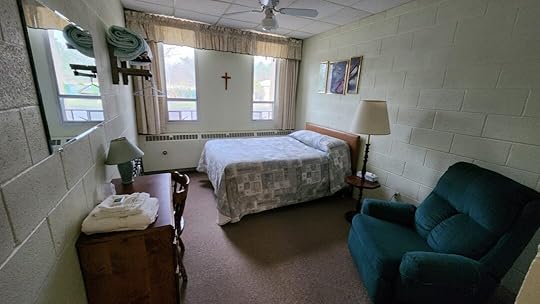
A monastic cell is the individual living space within the confines of a monastery that a monk retreats to. This sacred space offers solitude and silence for prayer, devotion, contemplative study, and seeking communion with God. It is the essence of the monastery in miniature. A monastic cell may also describe a stand-alone structure in a remote location, reminiscent of the wilderness caves of the Egyptian desert inhabited by the monks of the 4th to 6th centuries. The origin of the word “cell” comes from the Old French word “celle” derived from the Latin word “cella” meaning “room”, “store room”, or “chamber”. This was my monastic cell at a recent silent retreat I attended at the Sacramentine Monastery in Conway, MI.

As architecturally unique as each monastery is, so too are offshore lighthouses. Presuming to tame and civilize the inland seas that are the Great Lakes, man built lighthouses in the wilderness of water that boats are meant to conquer. What is an inland sea (or ocean), but a desert landscape covered by water? So sang the group America in their song, “A Horse with No Name.” White Shoal Lighthouse stands in the remote waters of northern Lake Michigan. Her original architecture featured ornate Greco-Roman columns covered by glistening white terra cotta tiles. These features are forever entombed in concrete and remain mostly unknown under her now iconic candy-cane stripe daymark.

An offshore lighthouse fulfills both definitions of a monastic cell. It is a stand-alone structure in a remote location and also contains individual rooms within for further retreat and solitude. (A cell within a cell.) Above is a sunrise seen from the window of my cell at White Shoal Light. This is where I begin and end my day with prayer and gratitude for the opportunity of keeping the light. Historically, my cell was used as a store room, fitting to the Latin word meaning “celle”.

DeTour Reef Light is located opposite White Shoal in the northern waters of Lake Huron at the foot of the St. Mary’s River. In stature, it is much smaller than White Shoal and architecturally distinct as well, save for their common wooden crib foundation only observed below the water line. I recently landed here as a first time keeper to assist in opening for the summer season. There is a reverence I feel living and working where, historically, women previously did not serve. These offshore stations were not built to house families. These were harsh and confined environments.
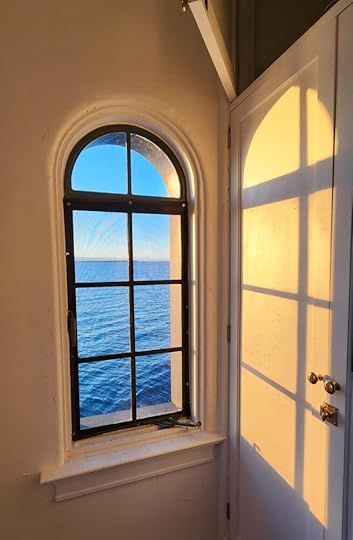
My “cell” at DeTour Reef Light with an east facing window to meet and greet the day. This historical head keeper’s room evokes a chapel-like atmosphere…perfect for prayer and meditation.

Jill Ore is an authoritative voice in the Michigan lighthouse community as well as a shining light for women desiring to re-imagine their life after age 50.
After recreating her life path after age 55, Jill now serves as Head Lighthouse Keeper of White Shoal Lighthouse and paves the way for adventure-driven volunteers and travelers to enjoy a bucket-list experience at this offshore location in northern Lake Michigan.
With over 30 years of experience as a hospital pharmacist and 8 years of experience in lighthouse volunteering, Jill has evolved and repurposed her skillset in guiding health restoration to lighthouse restoration. In 2023, Jill added Best Selling Author to her credentials in Shine Your Light, sharing her personal journey towards restoration in this collaborative book of illuminating stories that inspire resilience, self-discovery, and positive change.
The post Monk in the World Guest Post: Jill Ore appeared first on Abbey of the Arts.
May 31, 2025
Joy and Rest + Prayer Cycle Podcast Day 5
Dearest dancing monks, artists, and pilgrims,
At Easter I published a beautifully illustrated fairy tale titled Journey to Joy and later this month over the summer solstice I will be leading a two-day mini-retreat with guest musician Te Martin.
The story is about Sophia, a writer and woman in search of physical healing as she has experienced a long bout of illness and the joy in her village has also been depleted. I want to share an excerpt from it near the beginning, after Sophia decides to has to leave the village and find the Medicine Woman:
*****
At the river marking the eastern edge of the village, she came to the Bridge to the Beyond. This bridge had a Troll secretly living under it whose greatest delight was creating hardship for people. Every time someone crossed the bridge, the Troll would grow angry and would furtively steal their joy. Those who crossed were not aware and didn’t understand why they always felt so tired when leaving the village.
Because of Sophia’s weariness, she stumbled, and the Troll took advantage of the moment. Sophia blacked out briefly and when she awoke, unaware that the Troll was hidden in the darkness beneath the bridge, felt something drain from her.
Sophia continued on the path heading away from the village over what felt like an endless number of hills. When she came upon a stone to perch on or a tree to lean against, she paused to catch her breath or rest her aching feet. Sometimes she would eat an apple or some hazelnuts from her bag.
After arriving at the Medicine Woman’s house, she realized she felt even worse than when she left her home and questioned her decision to make this journey. Her body slumped further, and her heart felt like a deflated balloon. The Medicine Woman had already prepared a pot of nettle and hawthorn tea, as well as delicious morsels of nuts and dried fruits, and greeted her warmly. She seated Sophia on a pile of soft blankets and furs and offered her warm lavender-infused water to wash and refresh herself.
Aware of the source of Sophia’s worsened condition, once Sophia had rested and was refreshed, the Medicine Woman told her, “When people cross the bridge, the Troll steals a bit of joy from them. She uses her cursed magic to put the joy into jars and then hides them in a cave deep in the woods protected by a dragon she bewitched and enslaved.”
Sophia’s eyes widened. “How do I retrieve my stolen joy?” she asked.
“The joy must be retrieved on the night of the full moon and the path to get to that part of the forest is swampy and dangerous. You will need to move slowly, despite your rush to retrieve what you are looking for,” the Medicine Woman counseled.
Sophia rested a long while at the Medicine Woman’s home to strengthen her body for the journey ahead. She drank teas and tinctures made for her from various leaves, flowers, and roots. She ate bowls of delicious stew and sat in the fragrant herb garden in between her times of rest, and her body slowly felt restored enough for more traveling. The Medicine Woman also reminded Sophia of her own healing power through the words she wrote and told her, “You will need this gift for the journey you will make.”
Finally, after many days, the full moon rose round and white above the horizon and Sophia realized she had to go.
“But how will I find the Troll’s secret cave?” Sophia asked the Medicine Woman.
“The cave is hidden deep in the forest, guarded by the Troll’s dragon. Take Schatz (*Darling) my Drachenhund (*dragon hound). She will be your companion and sniff out the dragon. There, you will find the cave.”
The Medicine Woman packed her a satchel of supplies and sent Sophia on her way with her black, four-legged furry friend as a guide.
*****
If you want to know more about Sophia’s yearlong pilgrimage to reclaim her joy, consider joining us for the online retreat June 20 and 21. Or order a copy of the book and enjoy the illustrations and reflection questions at the end to guide you in integrating the story.
Today we release the audio podcast for Day 5 Morning and Evening Prayer on the theme of peace from our Cultivating Seeds of Liberation Prayer Cycle. Listen to the podcast here or on your favorite podcast app.
With great and growing love,
ChristineChristine Valters Paintner, OblSB, PhD, REACE
Illustration by Domenique Serfontein | Maiden Moose Studio
The post Joy and Rest + Prayer Cycle Podcast Day 5 appeared first on Abbey of the Arts.
May 27, 2025
Monk in the World Guest Post: Veronica Spasaro
I am delighted to share another beautiful submission to the Monk in the World guest post series from the community. Read on for Veronica Spasaro’s reflection Bread of Life.

Early morning and I enter the kitchen. I lift the mason jar off the top of the modem, the heat of which has kept the jar just warm overnight. I inspect the sides of the jar for signs of life. Bubbles have formed in the brownish sludge pressing against the glass sides. They form black holes reminiscent of craters on the moon’s surface and signify that life is indeed thriving within. I remove the cloth cover and hold the jar to my ear listening. I am reminded in that instant of the entrancement I experienced as a child on the beach, holding a shell to my ear and discovering with astonishment the entire ocean surging and sounding from within a tiny shell. Listening now, I hear a constant hum, a buzz, the sign of energetic activity in the jar. But there’s more. Above the hum, soft popping sounds as gases escape the surface, reveal that my starter is indeed alive and ready.
This pleases me greatly. Today then I can make bread. At the same time, I experience gratitude. None of this readiness is my doing. Though I have worked to create optimal conditions, the readiness of my starter is I know, beyond my control, seemingly influenced by weather and other mysterious factors impossible to gauge. Readiness I have learned is sheer gift and not available to me through my efforts alone, however careful. I am doubly grateful as today is a fine sunny day which will enable me to bake later using just sun power from the solar panels.
I turn to the gathering of ingredients. This recipe has been distilled over several years to be as life giving as I can make it. My primary focus is to honour the miracle of my body, to use ingredients that nourish and support the exquisite balance of the body and the 37 billion trillion chemical reactions taking place each second. I want also to work in harmony with Mother Earth. First, I grind sunflower seeds, flaxseeds, oats, almonds, buckwheat. To this I add arrowroot, psyllium. I am mindful of the farmers who have switched to organic farming methods to make available these clean products, free from chemicals, pesticides and herbicides. I am conscious too that this method of growing will not bring harm to farm workers. Yet I am humbled in the knowledge that the switch to organic farming methods does not come without huge cost. I am grateful for those who grow and sell these products as part of their commitment to integrity in business and to the nourishment and healing of our planet’s life-giving air, water and soils.
Sifting and mixing follow. I now add to the ingredients a portion of my lively starter together with water. I am suddenly conscious of the beauty and simplicity of this ordinary glass bowl – the roundness of it which enables me to perch the bowl on its edge, the better to mix; the smoothness of it which makes folding and turning so effortless. I am acutely aware that this ordinary bowl is gift and adds beauty and goodness to my life. I am reminded of the many who have been driven from their homes in war, or by fire, flood, earthquake and have lost access to all things both great and small that nurture their lives.
I continue with mixing and make minor adjustments to gain the right texture. I turn out the mixture into a deep soup bowl lined with a cotton tea towel. I place the bowl into the sun and wait, allowing for fermentation.
Time for baking. The oven has been heating for some time and I upend the sourdough onto the heated baking stone. A few slashes to the top to enable expansion while cooking, and then into the oven.
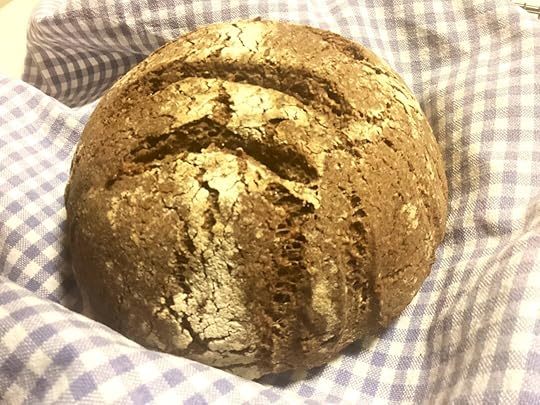
An hour later the aroma of fresh bread fills the house and I set the loaf onto the baking rack. I look, I smell, I touch. It seems perfect, inviting, alluring – a gem of a thing, offering sensory pleasure of infinite magnitude, almost beyond comprehension. Although I have made this bread hundreds of times over the years, I am once again in awe at what is produced. Something here in this ordinary task is both wondrous and tremendous – something I cannot quite grasp. Every loaf seems sheer miracle and grace and beauty and gift. In the very making is connection to the utter gratuitousness of life: access to healthy and safe ingredients, to fresh clean water, a lovely glass bowl for mixing, my hand and body that can grind and mix and measure, power for cooking and baking, as well as connection with unnumbered peoples the world over, who plant, grow, pick, pack, sell and dispatch with mindful intention and loving awareness.
Indeed, the whole process brings me to a very deep joy in life and into the goodness of all that is.
The bread has cooled and is tantalising. I cut some slices marvelling at the holes that are now inside the bread. I gather the crumbs, anxious to waste nothing of this precious loaf. As we sit to eat, I sense the communion of all life that converges to now provide this bread.
Fruit of the earth and work of human hands, this truly is the Bread of Life.

Veronica Spasaro lives on a beautiful rural property in community with two step children their
partners and 5 grandchildren. Together with her husband she is committed to the many dimensions
of living a whole-foods plant-based lifestyle, as sacred path to healing and wholeness for humanity
and the Earth.
The post Monk in the World Guest Post: Veronica Spasaro appeared first on Abbey of the Arts.
May 24, 2025
Cultivating Seeds of Liberation Prayer Cycle Day 4 Audio Podcast ~ A Love Note from Your Online Abbess
Dearest dancing monks, artists, and pilgrims,
Over the past few weeks we have released the audio podcasts for the first three days of our Cultivating Seeds of Liberation Prayer Cycle. This prayer cycle is deeply rooted in our commitment to contemplative practice as a way to ground ourselves in loving action. Today we are excited to share Day 4 on the theme of Justice. Here are two excerpts from morning and evening prayer.
Day 4 Morning Opening Prayer by Claudia Love Mair
We come together today, O Lover and Protector of all, because we understand that all of creation is made by you. We are all one, holy family. Grant us your vision of a family of your making, in which all are loved, protected, and cared for, and no one has too much, while others have too little. Help us to see that though diverse, we are equally loved. We share in the dignity of belonging to you, your beloved creation. Help us return to this family of origin, for if some of us know injustice, none of us will possess true abiding peace. Give us the strength to be love, to heal each other and the planet.
Day 4 Evening Closing Blessing by Cassidhe Hart
The God of justice strengthens your eyes
that you might see the truth of the world
as it is and as it was made to be.
The God of justice strengthens your ears
that you might listen to freedom songs arise
from the places you had overlooked.
The God of justice strengthens your mouth
that you might speak the truth with boldness
and hold reverent silence for another’s voice.
The God of justice strengthens your lungs
that you might breathe through the hard moments
of trying and failing and seeking reconciliation.
The God of justice strengthens your hands
that you might reach out in compassion
for partners on the journey.
The God of justice strengthens your feet
that you might walk with urgency and with patience
toward the hope for a flourishing Creation.
May God ground you in expansive love,
dance with you in dynamic creativity,
and strengthen you to embody justice
in your own time and place.
We will continue to release the audio podcasts over the next three weeks. It is a true joy to create this prayer cycle and offer it as free resource to meet the challenges facing our world today.
Thank you for listening and praying with us.
With great and growing love,
ChristineChristine Valters Paintner, OblSB, PhD, REACE
P.S. Join Betsey Beckman and friends on Saturday, May 31st to celebrate the release of The Love of Thousands: Dancing with Angels, Saints, and Ancestors video collection. Many of the dances are featured in The Love of Thousands Prayer Cycle video podcasts.
The post Cultivating Seeds of Liberation Prayer Cycle Day 4 Audio Podcast ~ A Love Note from Your Online Abbess appeared first on Abbey of the Arts.
May 20, 2025
Monk in the World Guest Post: Jo-ed Tome
I am delighted to share another beautiful submission to our Monk in the World guest post series from the community. Read on for Wisdom Council member Jo-ed Tome’s reflection Slower. Softer. Simpler.
I did not exactly set out to become a monk.
If someone had told my younger self that “monk” would one day be part of my self-description, I probably would have laughed and then quickly apologized because I was raised to be polite. But over the years, this monk-in-the-world identity has slowly revealed itself, not through lightning bolts or desert visions, but through the gentle rhythm of days shaped by silence, reflection, and cups of coffee savored instead of gulped.
I have often heard people say I am too young to be living like a monk. And to be fair, I still carry many of the longings typical of my generation—a promising career, a job that pays well, weekends filled with travel and adventure. But somewhere along the way, I began to crave something else. Something quieter. Something slower. I did not have the words for it at first, but it felt like a longing for a different rhythm. A way of living that did not leave me exhausted or fragmented. Over time, and with no small amount of detours, I found myself embracing a slower, softer, and simpler way of being.
This, I have come to realize, is what contemplative living is about. Slower. Softer. Simpler.
Not just prayer or silence (though those are part of it), but a deep commitment to live from within—to make space for presence, to tend to what’s essential, and to move through the world with a little more dependence on grace. It’s a posture of listening. Of resisting the pressure to perform or prove something. It’s a quiet form of courage.
At some point, I began calling myself a monk in the world. I live outside the monastery walls, with a hoodie instead of a habit, and the noise of daily life instead of bells marking the hours. But the impulse feels ancient: to live with intention, to hold space for the sacred in the everyday, to root myself in a rhythm that honors both soul and soil.
This unfolding—this slow becoming—found an important companion in the PAX Fellowship, particularly in the contemplative activism and spiritual formation cohort. The PAX Fellowship is a learning community for emerging Christians of color, rooted in peace, justice, and contemplation. It brings together like-hearted peers, mentors, and teachers to explore how ancient Christian wisdom can shape just and creative responses to the world’s needs.
I didn’t join expecting a dramatic change. But something about being among others who were also asking deep questions, seeking authentic ways to live out their values, and daring to slow down, helped something in me settle. It was like finding others who spoke a language I had not realized I was fluent in.
We touched on themes like inner work, vocation, justice, humility, and the call to wholeness. But more than the content, it was the shared spirit that stayed with me—a collective honoring of stillness and presence as transformative, not passive. It was the kind of community where silence is not empty, but full. The small shifts in how we live are seen as radical acts of faith.
One of the most affirming gifts of the fellowship was how it helped name and affirm what I had long sensed: that contemplative living is a form of activism. In a world that equates a good life with speed and productivity, choosing to slow down is countercultural. To soften—our expectations, our judgments, our want for control—is not weakness, but wisdom. To simplify is not to retreat from the world, but to walk more freely and lightly in it.
Slower. Softer. Simpler. These three words have quietly become my own Rule of Life, thanks to St. Benedict’s example. It reminds me who I am and how I want to show up. It calls me back when I get pulled into urgency or distraction. It definitely is not always easy. But it is profoundly life-giving.
Being a monk in the world means I still have deadlines, dishes, laundry, and the occasional existential crisis. But it also means I try to bring sacred attention to those very things. It means I resist the temptation to numb out or speed up when life gets hard. It means I choose relationships over rush, depth over display, presence over performance.
Of course, I still stumble more times than I can count. I still scroll mindlessly, say yes when I should have said no, and forget to breathe deeply when stress creeps in. But I also keep returning to my Rule. To the small practices that anchor me. To the stillness that reveals what’s truly mine to do.
The PAX Fellowship did not give me a new path. It illuminated the one I was already on. It helped me see this unfolding not as a detour from real life, but as a deep dive into it. It affirmed that there’s a quiet power in living slowly, loving gently, and simplifying enough to see clearly.
So no, I didn’t set out to be a monk. But perhaps the monk life found me—not in a cinematic kind of revelation, but in the ordinary grace of slowing down and paying attention.
And I think that’s the gift: to discover that contemplative living is not somewhere far away. It’s right here. In the unhurried breath. In the honest conversation. In the courage to live against the current, toward Life.

Jo-ed Tome is a Filipino spiritual director, transpersonal psychology researcher, and self-proclaimed monk in the world. He practices and promotes contemplative living through his social media platform, Millennial Tito* Monk. Jo-ed encourages others, especially the youth, to a mindful and compassionate exploration of various spiritual practices that respond to their unique contexts. He strongly believes that the Sacred is within each person as much as It is everywhere and in everything.
Among other practices, Jo-ed leads contemplative climb in mountains, soulful reading of books and other reading materials, and soulful conversations. He also gives retreats and recollections to various groups to help them grapple with questions about life, become witnesses to the dynamic presence of the Sacred in their lives, and connect deeply with their inner selves. Jo-ed earned his MSc in Consciousness, Spirituality and Transpersonal Psychology from Alef Trust in partnership with Liverpool John Moores University. He has a bachelor’s degree in Psychology from Ateneo de Naga University.
Jo-ed is available for spiritual direction. Contact him to inquire>> You may also visit Millennial Tito Monk’s website and Facebook Page.
The post Monk in the World Guest Post: Jo-ed Tome appeared first on Abbey of the Arts.
May 19, 2025
Christine Interviewed on the Podcast Find Your Center, Find Your Feet
Christine was interviewed on the podcast Find Your Center, Find Your Feet: Going Deeper in the Spiritual Life produced by the Moravian Seminary.
She had a lovely conversation with hosts Pam Rotelle Robertson & Marcella Kraybill-Greggo, Director of the Spiritual Direction Training Program at Moravian Seminary about writing, expressive arts, ancestors, and her new fairy tale Journey to Joy.
Listen here.The post Christine Interviewed on the Podcast Find Your Center, Find Your Feet appeared first on Abbey of the Arts.
May 17, 2025
Songs of Strength and Resilience + Prayer Cycle Audio Podcast Day 3
Dearest dancing monks, artists, and pilgrims,
We are blessed to have so many beautiful musicians in our community of dancing monks, artists, and pilgrims. This Friday, May 23rd, Wisdom Council member Te Martin will lead us in a mini-retreat on Sourcing from the Well: Songs of Strength and Resilience. Te offers this reflection on the power of song.
Little bird, listen to your songThere are bones buried deep deep down
They are rising from the ground
With your song
-Te Martin, “Little Bird"
Under tall pines and a night sky, we sang. There were songs from the Congo, Haiti, Iran, Armenia, Palestine, and Ireland. Tears of remembrance streamed down the faces of some gathered around this fire, under shooting stars. We could feel the bones rattling inside of us – our ancestors whispering in our ears,
“Keep singing! Sing – as we always have. Sing – it will get you through. Sing – it will give you strength… Remember the songs!”
This was last week at the Buckeye Gathering in northern California; an ancestral skills gathering where I was on the music team. For most of a week, we left behind our computers and phones and gathered to learn the old skills, one of which was (and is) the practice of singing in community.
And, oh, did we sing!
Amidst the heartbreak of these times, we opened our throats. We sang to stand with Palestine, we sang to end racialized violence and to stand for the safety of Black lives, and we sang for the waters and the trees. We sang our joy, too. We let our bodies sound, move, and dance, as people have throughout all of history.
Our ancestors have always sung their way through joy and pain. I stand on the shoulders of my keening Irish ancestors who knew to mourn the dead through song. I remember that amidst unfathomable violence, enslaved Africans in the U.S. gathered to sing, and their songs have rippled through generations. I remember that song is what helped Civil Rights activists cross the Edmund Pettus Bridge in Selma in 1965. I remember that when my grandmother was dying at age 99, I sang at her bedside; and after she died, I sang an old Irish blessing at her funeral.
Song is glue. It is fuel. It is medicine.
So let us gather to sing. Let us rattle the bones that have been buried for so long. What is your song that is waiting to sing through you?
During this retreat Te will teach short songs line-by-line on this theme and together we’ll draw from those reservoirs; there will be opportunities to learn songs as well as to share our hearts and voices with one another. Singers of all levels are welcome — experienced, new, or anywhere in-between!
Join us this Friday to sing songs of strength and resilience.
With great and growing love,
ChristineChristine Valters Paintner, OblSB, PhD, REACE
P.S. The audio podcast for Day 3 Morning and Evening Prayer of our Cultivating Seeds of Liberation Prayer Cycle, which takes as its theme Hope, is available to listen here or on your favorite podcast platform.
The post Songs of Strength and Resilience + Prayer Cycle Audio Podcast Day 3 appeared first on Abbey of the Arts.
May 14, 2025
Monk in the World Guest Post Call for Submissions
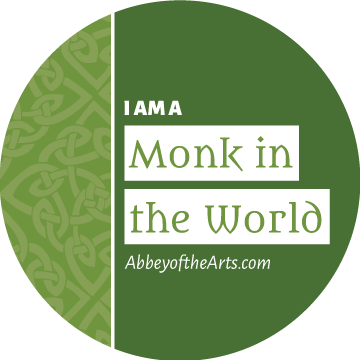
We welcome you to submit your reflection for possible publication in our Monk in the World guest post series. It is a gift to read how ordinary people are living lives of depth and meaning in the midst of the challenges of real life.
There are so many talented writers and artists in this Abbey community, so this is a chance to share your perspective. The link to the reflection will be included in our weekly newsletter which goes out to thousands of subscribers.
Submit your own post from one of the following categories on the general theme of “How do I live as a monk in the world? How do I bring contemplative presence to my work and/or family?” It works best if you focus your reflection on one aspect of your life or a practice you have, or you might reflect on how someone from the monastic tradition has inspired you. The Monk Manifesto is another source of inspiration. We invite reflections on the practice of living contemplatively.
Post categories:
Photo or visual art essay – Please include a one paragraph introduction about what inspired you and how the images relate to contemplative practice. You may submit 3-5 photographs with an optional 100-150 word description of each image. All work must be your own. Please make sure the image size is smaller than 1 MB.Poetry – Please include a one paragraph introduction to your poem or poems about what inspired you and how they relate to contemplative practice. You may submit up to 3 Haikus, 2 short poems (20 lines or less) or one long poem (up to 40 lines). You may also include 1 photograph or illustration. All work and images must be your own.Written reflection – Submit your post of 700-900 words. Please write from your own perspective and experience rather than offering instructions for others to follow. You may include 1-2 images if they help illustrate your reflection in meaningful ways. All images should be your own. Please make sure the image size is smaller than 1 MB.Please follow these instructions carefully:
Please click this link to read a selection of the posts and get a feel for the tone and quality.Please include a head shot and brief bio written in the third person (50 words max).If your reflection is specific to a season, feast day, or liturgical point in the year, please note that in the subject line of your submission.We will be accepting submissions between now and June 16th for publication sometime in the late summer and fall of 2025 and beyond (depending on the number of submissions). We reserve the right to make edits to the content as needed (or to request you to make edits) and submitting your reflection does not guarantee publication on the Abbey blog, but we will do our best to include as many of you as possible.Email your submission to Melinda by June 16th and include the reflection pasted into the body of your email and attach your photo(s). (Please do not embed your photos in a Word document.)We will be back in touch with you by late August to let you know if your post is accepted, if edits are needed, and/or when we have scheduled your post to appear.
The post Monk in the World Guest Post Call for Submissions appeared first on Abbey of the Arts.
May 13, 2025
Monk in the World Guest Post: Kiki McGrath
I am delighted to share another beautiful submission to the Monk in the World guest post series from the community. Read on for Kiki McGrath’s reflection and visual art essay Contemplative and Creative Practice.
For the past year I have been drawing and painting in a copy of Revelations of Divine Love, responding to this visionary text with graphite, oil pastel, and watercolor paint. Inspired by Julian of Norwich’s mystical experiences, I find her medieval life equally compelling: for more than twenty years she lived alone in an anchorhold—a room attached to a church—and wrote what is now the earliest surviving text by a woman in English. She also offered spiritual guidance to pilgrims and visitors, speaking from behind a black window curtain adorned with a white cross. Exploring religious history and finding ways to combine contemplative and creative practice are recurring themes in my artwork. Recently I constructed a temporary enclosure next to a stone chapel; visitors were invited to enter the cell and engage in solitary reflection, reading and writing. The Center for Prayer and Pilgrimage in Washington’s National Cathedral hosted this participatory installation to celebrate the 650th anniversary of Julian’s visions.
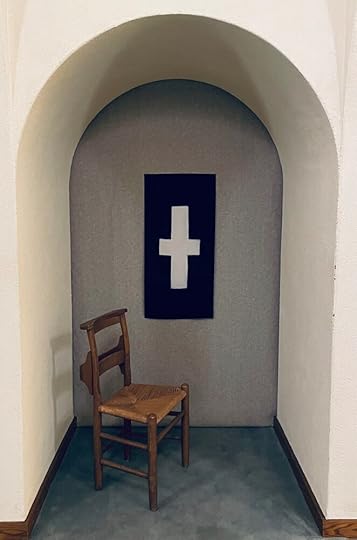
Exterior view of the curtained Anchorhold in Washington National Cathedral’s Center for Prayer and Pilgrimage, November 2023.
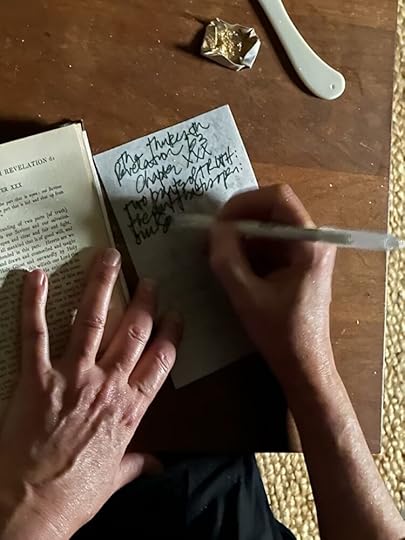
Writing Practice: transcriptions from the 13th Revelation.
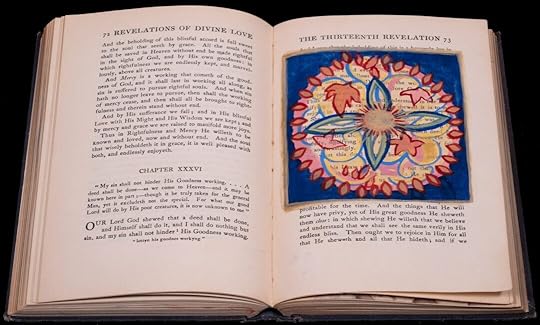
Altered artist book: Revelations of Divine Love, a version from the MS in the British Museum edited by Grace Warrack, 13th edition, 1949. Watercolor and gold paint.

Altered artist book: Revelations of Divine Love, a version from the MS in the British Museum edited by Grace Warrack, 13th edition, 1949. Graphite and oil pastel.

Sewing practice: All shall be well, by Terri Lynn Simpson and Carol Woodside. Textile and thread.

Kiki McGrath is an interdisciplinary artist who works in laundry rooms, monasteries, galleries, and gardens. A recipient of the Grünewald Guild’s Sacred Art Fellowship, she shares her work at KikiMcGrath.com.
The post Monk in the World Guest Post: Kiki McGrath appeared first on Abbey of the Arts.



